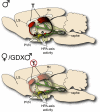Androgenic influence on serotonergic activation of the HPA stress axis
- PMID: 21385938
- PMCID: PMC3075941
- DOI: 10.1210/en.2010-0964
Androgenic influence on serotonergic activation of the HPA stress axis
Abstract
The higher incidence of stress-mediated affective disorders in women may be a function of gonadal hormone influence on complex interactions between serotonin and neural circuits that mediate the hypothalamic-pituitary-adrenal (HPA) stress axis. The paraventricular nucleus of the hypothalamus (PVN) receives serotonergic innervation, and selective serotonin reuptake inhibitors such as citalopram activate the HPA axis independent of stress. We have previously demonstrated that the magnitude of this serotonergic activation was greater in females and was attenuated by testosterone administration; however, the potential central sites of action where androgens reduce these serotonergic effects have not been determined. Therefore, we examined a time course of corticosterone production and used central c-Fos protein levels to assay neuronal activation in stress-related brain regions in female, male, and gonadectomized male mice after an acute citalopram injection (15 mg/kg). In the hippocampus, c-Fos-immunoreactivity was greater in males than in females or gonadectomized males. This same pattern emerged in the lateral septum after vehicle and gonadectomy reversed the effect of citalopram. These regions are important for inhibitory influences on the PVN, and accordingly, hippocampal c-Fos levels were negatively correlated with corticosterone production. No sex differences in c-Fos were detected in the PVN, cingulate cortex, or paraventricular thalamus in response to vehicle or citalopram. These data support brain region-specific regulation of the HPA axis where sex differences may be mediated partly through androgen enhancement of signaling in inhibitory regions.
Figures







Similar articles
-
Sex differences in the serotonergic influence on the hypothalamic-pituitary-adrenal stress axis.Endocrinology. 2010 Apr;151(4):1784-94. doi: 10.1210/en.2009-1180. Epub 2010 Feb 25. Endocrinology. 2010. PMID: 20185764 Free PMC article.
-
Selective contributions of the medial preoptic nucleus to testosterone-dependant regulation of the paraventricular nucleus of the hypothalamus and the HPA axis.Am J Physiol Regul Integr Comp Physiol. 2008 Oct;295(4):R1020-30. doi: 10.1152/ajpregu.90389.2008. Epub 2008 Aug 6. Am J Physiol Regul Integr Comp Physiol. 2008. PMID: 18685071
-
Acute glucocorticoid pretreatment suppresses stress-induced hypothalamic-pituitary-adrenal axis hormone secretion and expression of corticotropin-releasing hormone hnRNA but does not affect c-fos mRNA or fos protein expression in the paraventricular nucleus of the hypothalamus.J Neuroendocrinol. 2003 Nov;15(11):1075-83. doi: 10.1046/j.1365-2826.2003.01100.x. J Neuroendocrinol. 2003. PMID: 14622438
-
Gonadal steroid hormone receptors and sex differences in the hypothalamo-pituitary-adrenal axis.Horm Behav. 1994 Dec;28(4):464-76. doi: 10.1006/hbeh.1994.1044. Horm Behav. 1994. PMID: 7729815 Review.
-
Roles for androgens in mediating the sex differences of neuroendocrine and behavioral stress responses.Biol Sex Differ. 2020 Jul 29;11(1):44. doi: 10.1186/s13293-020-00319-2. Biol Sex Differ. 2020. PMID: 32727567 Free PMC article. Review.
Cited by
-
Mechanisms of antidepressant resistance.Front Pharmacol. 2013 Nov 22;4:146. doi: 10.3389/fphar.2013.00146. Front Pharmacol. 2013. PMID: 24319431 Free PMC article. Review.
-
Sex as a Biological Variable: Who, What, When, Why, and How.Neuropsychopharmacology. 2017 Jan;42(2):386-396. doi: 10.1038/npp.2016.215. Epub 2016 Sep 23. Neuropsychopharmacology. 2017. PMID: 27658485 Free PMC article. Review.
-
Associations Between Anxiety, Body Mass Index, and Sex Hormones in Women.Front Psychiatry. 2019 Jul 4;10:479. doi: 10.3389/fpsyt.2019.00479. eCollection 2019. Front Psychiatry. 2019. PMID: 31333520 Free PMC article.
-
Gonadal steroid hormones and the hypothalamo-pituitary-adrenal axis.Front Neuroendocrinol. 2014 Apr;35(2):197-220. doi: 10.1016/j.yfrne.2013.11.001. Epub 2013 Nov 16. Front Neuroendocrinol. 2014. PMID: 24246855 Free PMC article. Review.
-
The adipose tissue keeps the score: priming of the adrenal-adipose tissue axis by early life stress predisposes women to obesity and cardiometabolic risk.Front Endocrinol (Lausanne). 2024 Oct 18;15:1481923. doi: 10.3389/fendo.2024.1481923. eCollection 2024. Front Endocrinol (Lausanne). 2024. PMID: 39493777 Free PMC article. Review.
References
-
- Kendler KS, Karkowski LM, Prescott CA. 1999. Causal relationship between stressful life events and the onset of major depression. Am J Psychiatry 156:837–841 - PubMed
-
- Kessler RC, Berglund P, Demler O, Jin R, Merikangas KR, Walters EE. 2005. Lifetime prevalence and age-of-onset distributions of DSM-IV disorders in the National Comorbidity Survey Replication. Arch Gen Psychiatry 62:593–602 - PubMed
-
- Arborelius L, Owens MJ, Plotsky PM, Nemeroff CB. 1999. The role of corticotropin-releasing factor in depression and anxiety disorders. J Endocrinol 160:1–12 - PubMed
-
- Bale TL. 2005. Sensitivity to stress: dysregulation of CRF pathways and disease development. Horm Behav 48:1–10 - PubMed
-
- Holden C. 2005. Sex and the suffering brain. Science 308:1574. - PubMed

